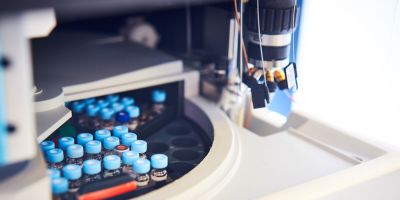Professor Andrew Nelson scores a hat-trick in winning European Framework awards

A novel electrochemical biosensor platform, which screens water for toxicants, is the core technology of three consecutive EU framework awards.
A novel electrochemical biosensor platform, which screens water for toxicants, and won a major Royal Society prize 10 years ago, is the core technology of three consecutive EU framework awards totalling €17m (€16m EU contribution): ENNSATOX (Framework 7, G.A. no. 229244); HISENTS (Horizon 2020, G.A. no. 685817); and, SABYDOMA (Horizon 2020, G.A. no. 862296).
Professor Andrew Nelson, from the School of Chemistry, designed the patented technology. It is composed of a phospholipid membrane-like layer on a fabricated microelectrode in flow cell, and is used to screen toxicants, pharmaceuticals and nanomaterials in waters.
The technology is the basis for the Horizon 2020 SABYDOMA programme, which revolutionises the ‘safety by design’ concept in the production of new nanomaterials by using a novel technology to manufacture safe nanomaterials. Professor Nelson is leading this highly ambitious program which began last April. SABYDOMA involves 19 International partners (15 from Europe) from Hong Kong to France and from Australia to Finland.
This multidisciplinary consortium is comprised of scientists from a diverse range of disciplines, including computer modellers electrochemists, medical implant manufacturers, engineers, biologists and in vitro toxicologists, and lawyers. An innovation project, SABYDOMA develops four industrial case studies enabling the technologies to be transferred to the industrial sector during the project’s lifetime.
We are especially proud of the successful achievement of the HISENTS demonstrator and the establishment of SABYDOMA, not only because the parent program Horizon 2020 is highly competitive, but also because of the challenging conditions in the wider environment.
The figure below shows how the high level control system concept (left) is specifically applied to construct the lead demonstrator (right) for production of safe nanomaterial. This demonstrator is one of the main outcomes of the project. SABYDOMA is a significant outcome from the previous, successful, HISENTS programme, whereby Andrew’s international team successfully developed a high-throughput screening platform based on microfluidic flow systems. HISENTS offered a step-change to the current state-of-art well-plate drug and toxicity testing technologies. Several partners from HISENTS are key participants in SABYDOMA.
SABYDOMA is a significant outcome from the previous, successful, HISENTS programme, whereby Andrew’s international team successfully developed a high-throughput screening platform based on microfluidic flow systems. HISENTS offered a step-change to the current state-of-art well-plate drug and toxicity testing technologies. Several partners from HISENTS are key participants in SABYDOMA.
Professor Nelson said: “We are especially proud of the successful achievement of the HISENTS demonstrator and the establishment of SABYDOMA, not only because the parent program Horizon 2020 is highly competitive, but also because of the challenging conditions in the wider environment.”
“HISENTS was executed and SABYDOMA was planned and initiated under the challenging atmosphere of Brexit and later the COVID-19 pandemic. Our success can be in part attributed to the warm loyalty and encouragement which we received from our European and International colleagues and friends.”
“I would also like to acknowledge Dr Karen Steenson and University of Leeds colleagues, including Professors Nik Kapur and Rik Drummond-Bryson. These colleagues have worked closely with me throughout the planning and execution of all three projects and I attribute much of the success in these ventures to our joint teamwork.
The SABYDOMA project has received funding from the European Union’s HORIZON 2020 Research & Innovation Programme under Grant Agreement no. 862296.






